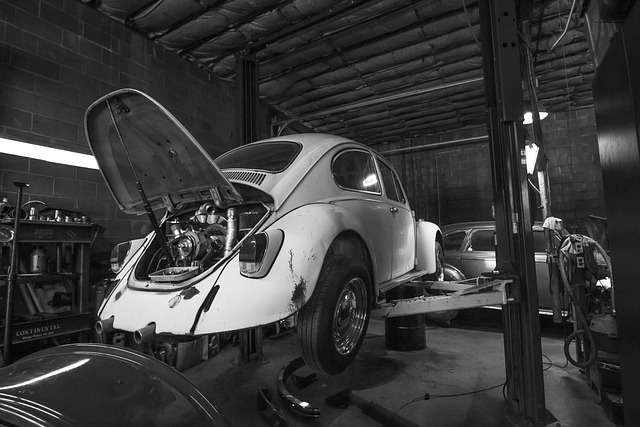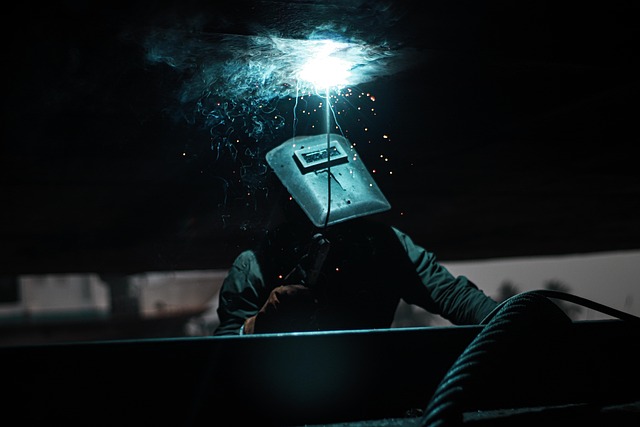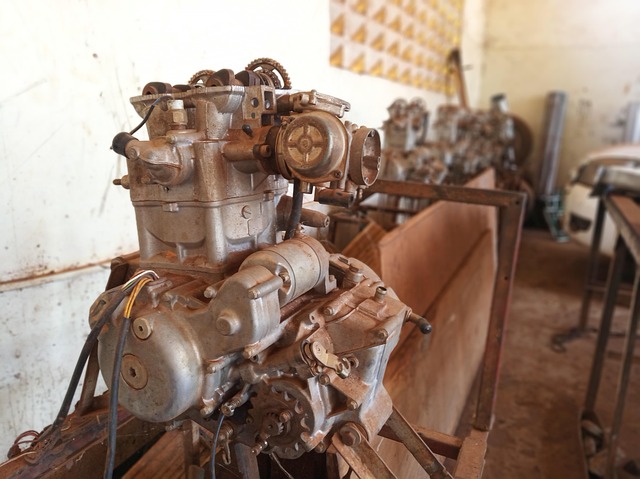Advanced Tools Transform Collision Repair Efficiency
Collision repair facilities are leveraging advanced frame-straightening tools to achieve precision,…….
Welcome to an in-depth exploration of collision repair facilities, the unsung heroes in the automotive industry responsible for restoring vehicles to their pre-accident condition. This article aims to unravel the complexities of these facilities, shedding light on their pivotal role in safety, sustainability, and economic growth. By delving into various aspects, from historical roots to future trends, readers will gain a holistic understanding of collision repair facilities’ significance in today’s world.
Definition: A collision repair facility is a specialized workshop or center designed to handle the intricate process of repairing damaged vehicles following accidents or collisions. These facilities are equipped with advanced tools, machinery, and trained personnel to ensure vehicles are restored to their original state or enhanced safety standards.
Core Components:
Historical Context: The concept of collision repair facilities emerged alongside the automotive industry itself. As vehicles became more complex and expensive, specialized services were needed to handle repairs efficiently and safely. Over time, these facilities have evolved from basic workshops to high-tech centers, incorporating advanced technologies for precision repairs and environmental sustainability.
Collision repair facilities are a global phenomenon, present in virtually every country with a significant automotive market. However, their presence, capacity, and sophistication vary widely across regions:
North America and Europe: Known for their stringent safety standards and advanced technological adoption, these regions boast well-established collision repair industries. Facilities here often employ robotic systems, advanced paint matching technology, and comprehensive training programs.
Asia Pacific: Rapidly growing automotive markets in countries like China and India have led to a surge in collision repair facilities. While the industry is still maturing, it shows significant potential for expansion and technological innovation.
Emerging Markets: In South America and Africa, the availability of collision repair services varies by country. Urban centers often support well-equipped facilities, while rural areas may lack specialized resources, highlighting the need for equitable access to automotive aftercare.
Trends Shaping the Industry:
The economic impact of collision repair facilities is profound, touching multiple sectors:
| Aspect | Description |
|---|---|
| Market Dynamics | These facilities form a vital link in the automotive supply chain, generating revenue from repair services, parts sales, and labor costs. The global collision repair market was valued at USD 241.5 billion in 2021 and is projected to grow at a CAGR of 5.2% (2022-2030). |
| Investment Patterns | Collision repair facilities require substantial investments in infrastructure, equipment, and skilled labor. Franchised operations often attract investors seeking stable, long-term returns. Independent shops may opt for more agile funding strategies to accommodate market fluctuations. |
| Economic Impact on Local Communities | They contribute to local economies through job creation, business development, and increased trade within the automotive sector. In regions with high vehicle ownership, these facilities can be economic catalysts. |
| Global Supply Chain Integration | Many facilities source parts from international suppliers, contributing to global trade and fostering interdependence among automotive markets. |
Technology plays a pivotal role in shaping the collision repair industry:
Computerized Estimation Systems: These tools provide accurate cost estimates for repairs by generating detailed damage reports and comparing them with historical data.
3D Body Scanning: Advanced scanners capture precise measurements of damaged vehicle panels, ensuring exact replacements and minimizing waste.
Robotic Welding and Assembly: Robotic systems offer greater precision, speed, and consistency in welding and assembly tasks, reducing labor costs and improving repair quality.
Virtual Reality (VR) Training: VR simulations provide immersive training experiences for technicians, allowing them to practice complex procedures in a risk-free environment.
AI-Driven Diagnostics: Artificial intelligence algorithms can analyze sensor data from vehicles to detect potential issues or identify the cause of unusual noises, vibrations, or performance problems.
The collision repair industry is subject to various policies and regulations that vary by region:
Safety Standards: Government bodies set minimum safety standards for repair facilities, including equipment requirements, training guidelines, and environmental compliance.
Licensing and Certification: Many jurisdictions mandate that technicians obtain licenses or certifications to operate within the industry. These ensure a certain level of proficiency and adhere to industry best practices.
Environmental Regulations: Strict rules govern waste management, emissions control, and the handling of hazardous materials, such as automotive fluids and toxic paint fumes.
Consumer Protection Laws: These protect customers’ rights, ensuring transparent pricing, informed consent for repairs, and the return of vehicles in a timely manner.
Insurance Industry Collaboration: Collision repair facilities often collaborate with insurance companies to streamline claim processing, negotiate rates, and provide efficient service to policyholders.
Despite its critical role, the collision repair industry faces several challenges:
Skilled Labor Shortage: The demand for trained technicians outstrips supply, leading to labor shortages in many regions. Addressing this requires comprehensive training programs and incentives to attract young talent.
Rapid Technological Change: Keeping up with advancing technologies can be challenging, requiring continuous investment in employee training and facility upgrades.
Environmental Concerns: The industry’s impact on the environment, from paint waste to energy consumption, has prompted criticism. Adopting eco-friendly practices and technologies is essential for sustainability.
Customer Trust and Transparency: Some customers express concerns about repair quality and hidden costs. Establishing trust through transparent pricing, quality assurance, and customer feedback systems is crucial.
Location: Los Angeles, CA, USA
Challenge: To create a collision repair facility that minimizes environmental impact while delivering top-notch service.
Solution: The Green Repair Center implemented several eco-initiatives:
Outcome: The facility achieved a 30% reduction in energy costs within the first year and gained recognition as an industry leader in sustainability. It attracted environmentally conscious customers and inspired similar initiatives across the country.
Location: Tokyo, Japan
Goal: Enhance operational efficiency and customer experience through digital technology.
Implementation: The Smart Repair Hub introduced:
Results: The facility experienced a 15% increase in customer satisfaction ratings and a 10% reduction in operational costs within six months of launch. It attracted tech-savvy customers and set a new standard for digital innovation in collision repair.
The collision repair industry is poised for significant growth and transformation, driven by several emerging trends:
Autonomous Vehicles: The rise of self-driving cars will impact the industry, creating new challenges and opportunities. Facilities may need to adapt to repairs specific to advanced driver assistance systems (ADAS) and autonomous vehicle technologies.
Connected Cars: The Internet of Things (IoT) will connect vehicles, enabling predictive maintenance and remote diagnostics. Collision repair facilities can leverage this data to offer proactive services, ensuring customer loyalty.
Advanced Materials: New materials like composite plastics and lightweight alloys require specialized repair techniques and tools. Facilities investing in training and equipment for these materials will be better positioned for future growth.
Sustainable Practices: As environmental concerns persist, eco-friendly technologies and processes will remain a focus. Facilities that embrace sustainability can attract environmentally conscious customers and gain a competitive edge.
Collision repair facilities are not just workshops; they are hubs of innovation, safety, and economic vitality. From their role in restoring vehicles to their original condition to contributing to environmental sustainability, these facilities play a critical role in modern society. As technology advances, regulatory frameworks evolve, and consumer expectations shift, the industry must adapt and innovate.
By embracing digital transformation, adopting sustainable practices, and addressing skill gaps, collision repair facilities can ensure they remain essential components of the automotive ecosystem. The future looks promising, with potential for growth, enhanced customer experiences, and continued contributions to road safety worldwide.
Q: How do I choose a reputable collision repair facility?
A: Look for facilities with good reviews, certifications (e.g., ASE), and transparent pricing. Check if they use modern equipment and have experienced technicians. Ask for references and compare estimates from multiple shops.
Q: Will my insurance cover all collision repair costs?
A: Insurance policies vary, so review your coverage carefully. Typically, comprehensive or collision coverage will pay for repairs due to accidents or damage, but deductibles apply. Be sure to understand what’s covered before initiating repairs.
Q: Are there eco-friendly options for vehicle paint jobs?
A: Yes, many modern paints are more environmentally friendly. Facilities using water-based or low-VOC (volatile organic compound) paints minimize harmful emissions and contribute to a cleaner environment.
Q: Can I get my car repaired while it’s still under warranty?
A: It depends on the manufacturer’s terms. Some warranties may void coverage if repairs aren’t performed by authorized dealers or facilities. Check with your dealer or manufacturer for specific guidelines regarding collision repairs.
Q: How can I ensure my vehicle is safe after collision repair?
A: Reputable facilities will perform thorough inspections and test drives to ensure safety. Look for certifications indicating that the facility adheres to safety standards, and don’t hesitate to ask about their quality control processes.

Collision repair facilities are leveraging advanced frame-straightening tools to achieve precision,…….

Customers seeking collision repair services expect clear, transparent pricing from reputable facilit…….

In a collision repair facility, safety is paramount, with facilities investing in equipment, trainin…….

Choosing Original Equipment Manufacturer (OEM) parts for collision repairs is crucial for vehicle sa…….

Collision repair facilities offer a comprehensive range of services beyond painting and dent removal…….

When choosing a collision repair facility after an accident, select a reputable shop offering compre…….

The collision repair industry has embraced digital technology, revolutionizing how facilities operat…….

Advanced frame straightening tools have revolutionized collision repair facilities, improving effici…….

Achieving accurate color matching in collision repair is a critical aspect of restoring vehicles to…….

Choosing a reputable collision repair facility is paramount for both vehicle safety and restoring it…….